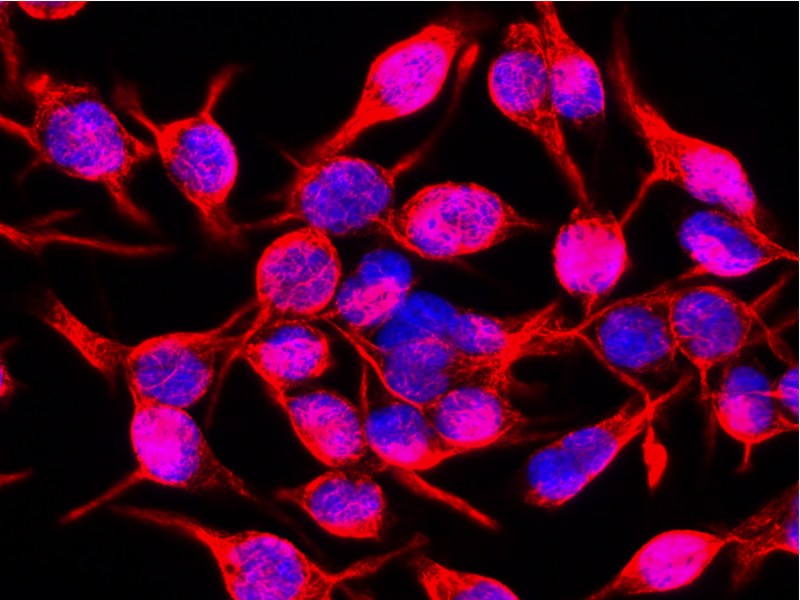Vimentin (VIM) Mouse Monoclonal Antibody [Clone ID: VI-10]
CAT#: SM3166P
Vimentin (VIM) mouse monoclonal antibody, clone VI-10, Purified
Need it in bulk or conjugated?
Get a free quote
CNY 3,540.00
货期*
5周
规格
| Cited in 1 publication. |
Specifications
| Product Data | |
| Clone Name | VI-10 |
| Applications | IF, IHC, IP, WB |
| Recommend Dilution | Immunohistochemistry on Paraffin Sections: 5 µg/ml. Positive tissue: Skin fibroblast. Western blotting. Immunocytochemistry. Immunoprecipitation. Staining Technique: RBL basophilic leukemia cell line: (a) Fix cells for 10 min in methanol at -20°C and for 6 min in acetone at -20°C. (b) Fix cells directly in methanol for 10 min at -20°C or in acetone for 10 min at -20°C. Incubation: 45 min RT. Positive Control: 3T3 mouse Swiss albino fibroblast cell line RBL rat basophilic cell line |
| Reactivity | Human, Porcine, Mouse, Rat, Chicken |
| Host | Mouse |
| Clonality | Monoclonal |
| Specificity | The antibody VI-10 reacts with vimentin, a 57 kDa intermediate filament expressed in variety of mesenchymal and mesodermal cell types. |
| Formulation | Phosphate buffered saline (PBS), pH~7.4 State: Purified State: Liquid purified Ig fraction (> 95% pure by SDS-PAGE) Preservative: 15 mM Sodium Azide |
| Concentration | lot specific |
| Purification | Precipitation methods and Size-Exclusion Chromatography |
| Conjugation | Unconjugated |
| Storage Condition | Store the antibody at 2-8°C. DO NOT FREEZE! |
| Gene Name | vimentin |
| Database Link | |
| Background | Vimentin (57 kDa) is the most ubiquituos intermediate filament protein and the first to be expressed during cell differentiation. All primitive cell types express vimentin but in most non-mesenchymal cells it is replaced by other intermediate filament proteins during differentiation. Vimentin is expressed in a wide variety of mesenchymal cell types - fibroblasts, endothelial cells etc., and in a number of other cell types derived from mesoderm, e.g., mesothelium and ovarian granulosa cells. In non-vascular smooth muscle cellsand striated muscle, vimentin is often replaced by desmin, however, during regeneration, vimentin is reexpressed. Cells of the lymfo-haemopoietic system (lymphocytes, macrophages etc.) also express vimentin, sometimes in scarce amounts. Vimentin is also found in mesoderm derived epithelia, e.g. kidney (Bowman capsule), endometrium and ovary (surface epithelium), in myoepithelial cells (breast, salivary and sweat glands), an in thyroid gland epithelium. In these cell types, as in mesothelial cells, vimentin is coexpressed with cytokeratin . Furthermore, vimentin is detected in many cells from the neural crest. Particularly melanocytes express abundant vimentin. In glial cells vimentin is coexpressed with Glial Fibrillary Acidic Protein (GFAP). Vimentin is present in many different neoplasms but is particulary expressed in those originated from mesenchymal cells. Sarcomas e.g., fibrosarcoma, malignt fibrous histiocytoma, angiosarcoma, and leio- and rhabdomyosarcoma, as well as lymphomas, malignant melanoma and schwannoma, are virtually always vimentin positive. Mesoderm derived carcinomas like renal cell carcinoma, adrenal cortical carcinoma and adenocarcinomas from endometrium and ovary usually express vimentin. Also thyroid carcinomas are vimentin positive. Any low differentiated carcinoma may express some vimentin. Vimentin is frequently included in the so-called primary panel (together with CD45, cytokeratin, and S-100 protein). Intense staining reaction for vimentin without coexpression of other intermediate filament proteins is strongly suggestive of a mesenchymal tumour or malignant melanoma. |
| Synonyms | VIM |
| Reference Data | |
Citations (1)
| The use of this Antibodies has been cited in the following citations: |
|---|
|
Monoclonal antibody VI-10 specific for vimentin
,Draberova E, Zmkova M, Draber P,
Folia Biol. (Praha) 2000
,PubMed ID 10732717
[VIM]
|
Documents
| Product Manuals |
| FAQs |
| SDS |
Resources
| 抗体相关资料 |
Customer
Reviews
Loading...


 United States
United States
 Germany
Germany
 Japan
Japan
 United Kingdom
United Kingdom
 China
China



